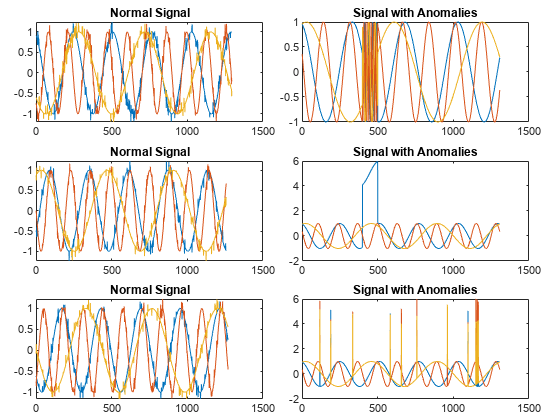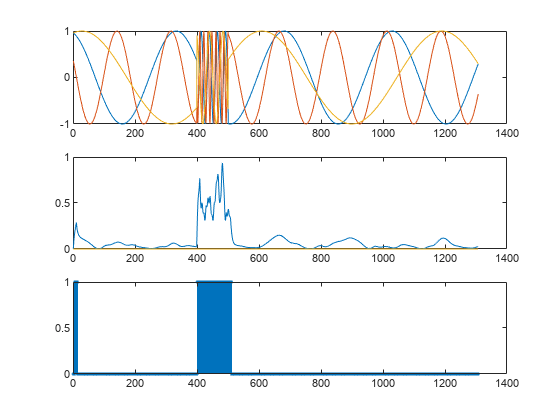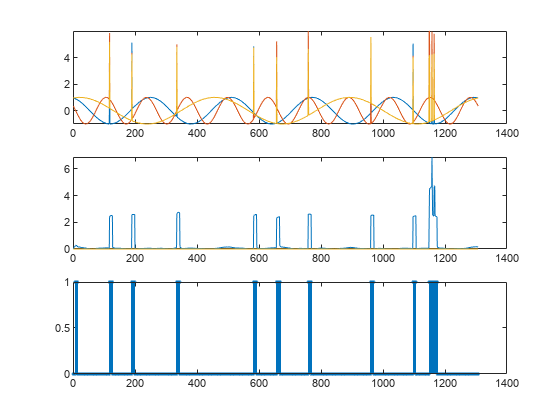deepSignalAnomalyDetectorLSTMForecaster
Description
The deepSignalAnomalyDetectorLSTMForecaster object uses a long short-term memory (LSTM)
forecaster model to detect signal anomalies.
Creation
Create a deepSignalAnomalyDetectorLSTMForecaster object using deepSignalAnomalyDetector and specifying "lstmforecaster" as
the model type.
Properties
General
This property is read-only.
Training status, returned as 0 (false) or
1 (true). Once you train the detector,
IsTrained is equal to 1.
Data Types: logical
This property is read-only.
Number of channels in each input signal, returned as a positive integer.
Data Types: single | double | int8 | int16 | int32 | int64 | uint8 | uint16 | uint32 | uint64
Model
This property is read-only.
Type of deep learning model implemented by the detector, returned as
"lstmforecaster".
This property is read-only.
Number of steps forward for forecasting, returned as a positive integer scalar.
Data Types: single | double | int8 | int16 | int32 | int64 | uint8 | uint16 | uint32 | uint64
This property is read-only.
Number of hidden units of LSTM layers, returned as a positive integer scalar or a vector of positive integers. The ith element of the vector sets the number of hidden units in the ith layer.
Data Types: single | double | int8 | int16 | int32 | int64 | uint8 | uint16 | uint32 | uint64
Window
This property is read-only.
Window length of each signal segment, returned as a positive integer or as
"fullSignal".
If
WindowLengthis an integer, the detector divides each input signal into segments. The length of each segment is equal to theWindowLengthvalue in samples.If
WindowLengthis"fullSignal", the detector treats each input signal as a single segment.
Use updateDetector to modify this and other window properties.
Data Types: single | double | int8 | int16 | int32 | int64 | uint8 | uint16 | uint32 | uint64 | char | string
This property is read-only.
Number of overlapped samples between window segments, returned as a positive integer
or as "auto".
If
OverlapLengthis a positive integer, the detector sets the number of overlapped samples equal to theOverlapLengthvalue.If
OverlapLengthis"auto", the detector sets the number of overlapped samples equal toWindowLength– 1.
Data Types: single | double | int8 | int16 | int32 | int64 | uint8 | uint16 | uint32 | uint64 | char | string
This property is read-only.
Method to aggregate sample loss within each window segment, returned as one of these:
"max"— Compute the aggregated window loss as the maximum value of all the sample losses within the window."mean"— Compute the aggregated window loss as the mean value of all the sample losses within the window."median"— Compute the aggregated window loss as the median value of all the sample losses within the window."min"— Compute the aggregated window loss as the minimum value of all the sample losses within the window.
Data Types: char | string
Threshold
This property is read-only.
Method to compute the detection threshold, returned as one of these:
"contaminationFraction"— Value corresponding to the detection of anomalies within a specified fraction of windows. The fraction value is specified byThresholdParameter."max"— Maximum window loss measured over the entire training data set and multiplied byThresholdParameter."median"— Median window loss measured over the entire training data set and multiplied byThresholdParameter."mean"— Mean window loss measured over the entire training data set and multiplied byThresholdParameter."manual"— Manual detection threshold value based onThreshold."customFunction"— Custom detection threshold value based onThresholdFunction.
Use updateDetector to modify this and other threshold properties.
Data Types: char | string
This property is read-only.
Detection threshold, returned as a nonnegative scalar when you set
ThresholdMethod to "contaminationFraction",
and as positive scalar when you set ThresholdMethod to
"max", "median", or
"mean".
Data Types: single | double | int8 | int16 | int32 | int64 | uint8 | uint16 | uint32 | uint64
This property is read-only.
Manual detection threshold, returned as a positive scalar. This property applies only when you
set ThresholdMethod to
"manual".
Data Types: single | double | int8 | int16 | int32 | int64 | uint8 | uint16 | uint32 | uint64
This property is read-only.
Function to compute custom detection threshold, returned as a function handle. This property
applies only when you set ThresholdMethod to
"customFunction".
Data Types: function_handle
Object Functions
detect | Detect anomalies in signals |
getModel | Get underlying neural network model of signal anomaly detector |
plotAnomalies | Plot signal anomalies |
plotLoss | Plot window reconstruction loss |
plotLossDistribution | Plot CDF and histogram of aggregated window loss distribution |
resetState | Reset model internal states |
saveModel | Save detector network and parameters |
trainDetector | Train signal anomaly detector |
updateDetector | Update settings of trained detector and recompute detection threshold |
Examples
Load the file sineWaveAnomalyData.mat, which contains two sets of synthetic three-channel sinusoidal signals.
sineWaveNormalcontains the 10 sinusoids used to train the convolutional anomaly detector. Each signal has a series of small-amplitude impact-like imperfections but otherwise has stable amplitude and frequency.sineWaveAbnormalcontains three signals of similar length and amplitude to the training data. One of the signals has an abrupt, finite-time change in frequency. Another signal has a finite-duration amplitude change in one of its channels. A third has random spikes in each channel.
Plot three normal signals and the three signals with anomalies.
load sineWaveAnomalyData tiledlayout(3,2,TileSpacing="compact",Padding="compact") rnd = randperm(length(sineWaveNormal)); for kj = 1:length(sineWaveAbnormal) nexttile plot(sineWaveNormal{rnd(kj)}) title("Normal Signal") nexttile plot(sineWaveAbnormal{kj}) title("Signal with Anomalies") end

Create a long short-term memory (LSTM) forecaster object to detect the anomalies in the abnormal signals. Specify a window length of 10 samples.
D = deepSignalAnomalyDetector(3,"lstmforecaster",windowLength=10);Train the forecaster using the anomaly-free sinusoids. Use the training options for the adaptive moment estimation (Adam) optimizer and specify a maximum number of 100 epochs. For more information, see trainingOptions (Deep Learning Toolbox).
opts = trainingOptions("adam",MaxEpochs=100,ExecutionEnvironment="cpu"); trainDetector(D,sineWaveNormal,opts)
Iteration Epoch TimeElapsed LearnRate TrainingLoss
_________ _____ ___________ _________ ____________
1 1 00:00:01 0.001 0.6369
50 50 00:00:04 0.001 0.19706
100 100 00:00:07 0.001 0.064225
Training stopped: Max epochs completed
Computing threshold...
Threshold computation completed.
Use the trained detector to find the anomalies in the first signal. Reset the state of the detector. Stream the data one sample at a time and have the detector keep its state after each reading. Compute the reconstruction loss for each one-sample frame. Categorize signal regions where the loss exceeds a specified threshold as anomalous.
resetState(D)
sg = sineWaveAbnormal{1};
anoms = NaN(size(sg));
losss = zeros(size(sg));
for kj = 1:length(sg)
frame = sg(kj,:);
[lb,lo] = detect(D,frame, ...
KeepState=true,ExecutionEnvironment="cpu");
anoms(kj) = lb;
losss(kj) = lo;
endPlot the anomalous signal, the reconstruction loss, and the categorical array that declares each sample of the signal as being anomalous or not.
figure tiledlayout("vertical") nexttile plot(sg) nexttile plot(losss) nexttile stem(anoms,".")

Reset the state of the detector. Find the anomalies in the third signal. Plot the anomalous signal, the reconstruction loss, and the categorical array that declares each sample of the signal as being anomalous or not.
resetState(D)
sg = sineWaveAbnormal{3};
anoms = NaN(size(sg));
losss = zeros(size(sg));
for kj = 1:length(sg)
frame = sg(kj,:);
[lb,lo] = detect(D,frame, ...
KeepState=true,ExecutionEnvironment="cpu");
anoms(kj) = lb;
losss(kj) = lo;
end
figure
tiledlayout("vertical")
nexttile
plot(sg)
nexttile
plot(losss)
nexttile
stem(anoms,".")
Extended Capabilities
The deepSignalAnomalyDetectorLSTMForecaster function
supports GPU array input with these usage notes and limitations:
The
ExecutionEnvironmentoption must be"gpu"or"auto"when the input data is:A
gpuArrayA cell array containing
gpuArrayobjectsA datastore that outputs cell arrays containing
gpuArrayobjects
For more information, see Run MATLAB Functions on a GPU (Parallel Computing Toolbox).
Version History
Introduced in R2024a
See Also
Functions
Objects
Topics
- Detect Anomalies in Signals Using deepSignalAnomalyDetector
- Detect Anomalies in Machinery Using LSTM Autoencoder
- Detect Anomalies in ECG Data Using Wavelet Scattering and LSTM Autoencoder in Simulink (DSP System Toolbox)
- Detect Anomalies in Industrial Machinery Using Three-Axis Vibration Data (Predictive Maintenance Toolbox)
MATLAB Command
You clicked a link that corresponds to this MATLAB command:
Run the command by entering it in the MATLAB Command Window. Web browsers do not support MATLAB commands.
选择网站
选择网站以获取翻译的可用内容,以及查看当地活动和优惠。根据您的位置,我们建议您选择:。
您也可以从以下列表中选择网站:
如何获得最佳网站性能
选择中国网站(中文或英文)以获得最佳网站性能。其他 MathWorks 国家/地区网站并未针对您所在位置的访问进行优化。
美洲
- América Latina (Español)
- Canada (English)
- United States (English)
欧洲
- Belgium (English)
- Denmark (English)
- Deutschland (Deutsch)
- España (Español)
- Finland (English)
- France (Français)
- Ireland (English)
- Italia (Italiano)
- Luxembourg (English)
- Netherlands (English)
- Norway (English)
- Österreich (Deutsch)
- Portugal (English)
- Sweden (English)
- Switzerland
- United Kingdom (English)